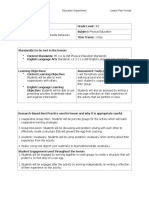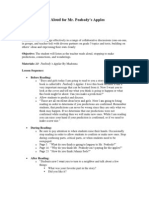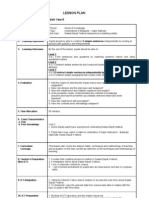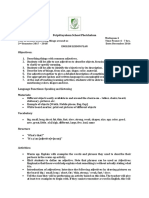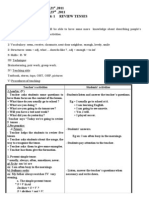Planning, by Harry Dodds and Lorna Smith: Why Is A Lesson Plan Important?
Uploaded by
Issa VandanaPlanning, by Harry Dodds and Lorna Smith: Why Is A Lesson Plan Important?
Uploaded by
Issa VandanaPlanning, by Harry Dodds and Lorna Smith
This deals with the absolute bare bones of planning. For a fuller picture, please also look at the related articles, Blooms Taxonomy, Starters and Plenaries, What makes an effective lesson?, and Assessment but read this first. Writing your first lessons plans will take you a long time. Dont despair - this will become quicker and easier as you begin to internalise all the information and skills that lie beneath a good plan.
Why is a lesson plan important? Because it: provides you with a structured route through your lesson so that you can be sure of meeting your gives you a secure base from which you can project to your class the impression that you are lesson objective(s). organised and that you know what you are doing. (That is one of the important elements of effective behaviour management.) provides you, your mentor, your tutors and colleagues with insights into the way you are offers (over a number of lessons) evidence that you are addressing the requirements of almost approaching your teaching, and shows that you are helping your pupils make progress. every Standard other than Q17.
What is a lesson plan? Its a simple statement of: what your pupils are going to learn how you intend them to learn it how you will know that the learning has taken place.
How do I write a lesson plan? Stage 1 The starting point for any lesson plan must be, What do I want pupils to learn? If you begin by answering that question, and call your answer a Learning Objective, then your planning will stay focused. If you look at the Blooms Taxonomy resource, you will find some active verbs that might help you identify the Learning Objective and build sequences of learning. Unless it is a one off lesson, the Learning Objective will usually come from a Medium Term Plan, or Scheme/Unit of Work either one that you have prepared yourself, or one prepared by your school.
This resource was downloaded from www.teachit.co.uk The Training Ground
Page 1 of 3
Planning, by Harry Dodds and Lorna Smith
Stage 2 Your course documents will include a standard proforma for writing lesson plans. Your school will have its own version, not necessarily the same. (Your university will provide guidance on which proformas to use and when.) A lesson plan will usually contain these elements: 1. A context. Indicate where the lesson fits into the Medium Term Plan / Scheme of Work or Programme of Study. Use references to the National Curriculum e.g. EN3 1b and / or Assessment Objectives drawn from exam specifications. 2. A statement both of success criteria and of the means by which you will assess the success of the lesson what learning has taken place, and how effectively. Make these explicit to the class, probably early in the lesson.
3. An outline of your proposed activities, with an approximation of timings. Anticipate likely difficulties here,
and record not just what you will do, but how you will do it. For example, if you want pupils to move to the front of the classroom, think how you will manage the movement so you dont provoke a single mad rush of thirty bodies. Pupils move to the front in threes and fours and sit where directed would do. It is crucial to remember that the proposed activities should always lead the pupils in the direction of the Learning Objective: you must be clear about WHY each activity is a necessary element of the lesson (and your university may ask you to justify the learning outcome of each activity on your plan). In other words, however engaging or fun your idea is, if it doesnt contribute toward the end goal, dont do it! (File away your idea for another time) At this point in your planning, be specific about: how you will begin and end the lesson how you will group pupils how you will manage transitions between activities and separate phases of the lesson.
4. Statements of individual pupils specific learning needs, determined with reference to IEPs, EAL, SEN, G & T, learning and / or behaviour targets, or other requirements, and of how you propose to meet those needs. These are the first steps towards providing effective differentiation. 5. Acknowledgement of the role a TA or LSA might play in the lesson. 6. An account of the resources you will use everything from texts and worksheets to glue and scissors. Again, make your strategies for managing these resources quite clear. The same goes for your use of audio-visual or other equipment. 7. Use of ICT, with a clear statement of the ways in which it enhances learning. 8. Notes on Health and Safety considerations. In the typical English classroom this is usually about stray cables and stowing bags under tables, but, again, anticipate. If, for the first two or three lessons you feel safer by writing yourself a script, thats fine, but as you become more confident you should be able to move towards a more economical model. The exception to this
This resource was downloaded from www.teachit.co.uk The Training Ground
Page 2 of 3
Planning, by Harry Dodds and Lorna Smith
advice is when you are structuring a sequence of questions. Theres nothing wrong with scripting them, just to be sure that you dont miss out something important and try to be prepared to be flexible. Stage 3 Assessment How will you know that any learning has taken place? You cant just assume it, so you must at some point, or points, during the lesson build in opportunities to check pupils understanding, whether that be orally or by more formal means. Again, be specific about how you will do this. Planning in Practice getting the structure right Inspired by the National Strategy, most model lesson plans contain four parts: Part 1. A short starter activity, involving the whole class in some way. This is as much as anything to engage pupils in the lesson and to wake them up, but should also assess or refresh prior knowledge, to bridge learning from previous lessons into the current one. Five to ten minutes is usually quite long enough. Part 2. An introduction to the main points that you want pupils to learn, perhaps through contextualisation, questioning, or plain exposition. Part 3. Development and consolidation. In this phase, encourage pupils to make the new learning their own, perhaps by applying it or re-stating it. Pupils might work in groups, pairs, individually, or in a mixture of all three, depending on how you have decided is best to meet the Learning Objectives. Part 4. Plenary. In this phase, you make the learning explicit, perhaps by structured questioning, feedback from pupils as presentations or as brief accounts. Pupils should be able to articulate in some way what they have learnt in the lesson, and you will be able to assess what learning has taken place, and how effectively. When you observe teachers in schools, consider how far each of them follows this four-part plan, and the reasons for any deviations from it. For example, you may see teachers conduct mini-plenaries midway through the lesson. Talk with teachers about how they structure their lessons and their reasons for doing so. You will find support for planning in the DCFS materials, Pedagogy and Practice: Teaching and Learning in Secondary Schools. The full set of 20 study units and DVDs comes in a big box file, DCFS reference number 0423-2004, but you can download the essentials from http://nationalstrategies.standards.dcsf.gov.uk/node/97131 The contents include: Units 1-5 Designing lessons Units 6-11 Teaching repertoire Units 12-17 Creating effective learners Units 18-20 Creating conditions for learning
This resource was downloaded from www.teachit.co.uk The Training Ground
Page 3 of 3
You might also like
- What Are The 5 Parts of A Lesson?: 1. Objectives100% (4)What Are The 5 Parts of A Lesson?: 1. Objectives4 pages
- A Detailed Lesson Plan-Developmental ReadingNo ratings yetA Detailed Lesson Plan-Developmental Reading4 pages
- Principles of Textile Testing by Je Booth 0592063259 PDF20% (5)Principles of Textile Testing by Je Booth 0592063259 PDF5 pages
- Edpr3002 Health and Physical Education Semester 1 2018 Bentley Campus IntNo ratings yetEdpr3002 Health and Physical Education Semester 1 2018 Bentley Campus Int13 pages
- Chemometrics: Views A N D Propositions?: Chemistry. UniversityNo ratings yetChemometrics: Views A N D Propositions?: Chemistry. University3 pages
- Education Department Condensed Lesson Plan TemplateNo ratings yetEducation Department Condensed Lesson Plan Template3 pages
- Lesson Plan Template Adapted For Ece 314/T&L 441 (Ece - Prek To 2 Grade)No ratings yetLesson Plan Template Adapted For Ece 314/T&L 441 (Ece - Prek To 2 Grade)3 pages
- Covenant University Postgraduate AdmissionNo ratings yetCovenant University Postgraduate Admission1 page
- Prepositions of Place English Lesson Plan For BeginnersNo ratings yetPrepositions of Place English Lesson Plan For Beginners4 pages
- Unit 9 Caring and Sharing Year 2 KSSR Lesson PlanNo ratings yetUnit 9 Caring and Sharing Year 2 KSSR Lesson Plan6 pages
- 2a English Sequence and Lesson Plans AutosavedNo ratings yet2a English Sequence and Lesson Plans Autosaved42 pages
- Choose From The 16 Elements of EMK Appropriate To The Topic.No ratings yetChoose From The 16 Elements of EMK Appropriate To The Topic.4 pages
- FABRICATION OF FOUR WAY HACKSAW BLADE MACHINE Ijariie2072 PDFNo ratings yetFABRICATION OF FOUR WAY HACKSAW BLADE MACHINE Ijariie2072 PDF9 pages
- Sales Commission Quick Guide LS Retail NAV 6.3No ratings yetSales Commission Quick Guide LS Retail NAV 6.328 pages
- The Fuselage Cross Section and Nose Is Derived From That of TheNo ratings yetThe Fuselage Cross Section and Nose Is Derived From That of The6 pages
- B.tech.-All Branches - Final Date Sheet-June 2013 IPUNo ratings yetB.tech.-All Branches - Final Date Sheet-June 2013 IPU5 pages
- Virtual System For Airport (Vision Document)No ratings yetVirtual System For Airport (Vision Document)11 pages
- Form 3 English Home Based Learning Module 2021No ratings yetForm 3 English Home Based Learning Module 202113 pages
- DI-C001-1339A Combined Upgrade Instructions 6135 - 6753 To 6742 PDFNo ratings yetDI-C001-1339A Combined Upgrade Instructions 6135 - 6753 To 6742 PDF36 pages






